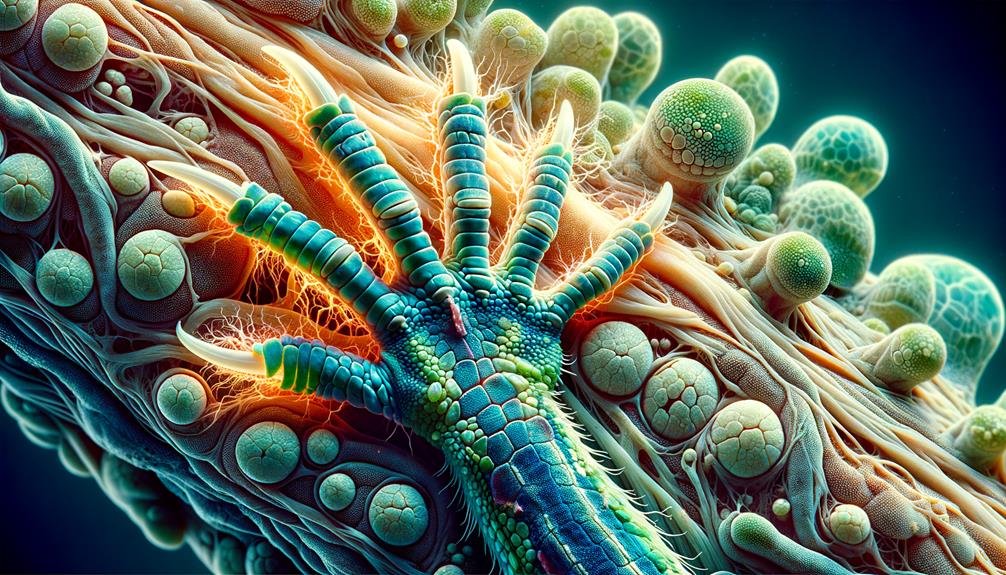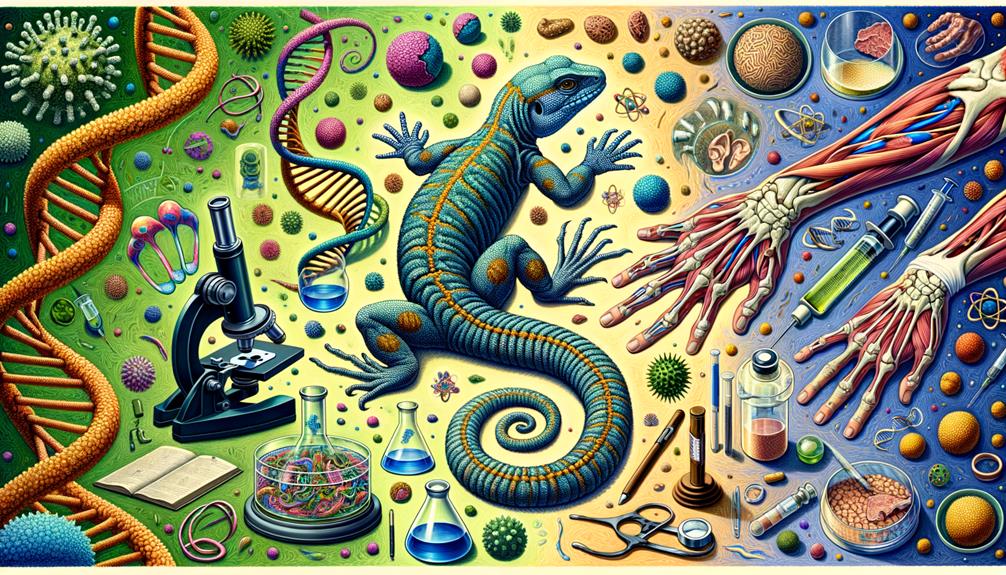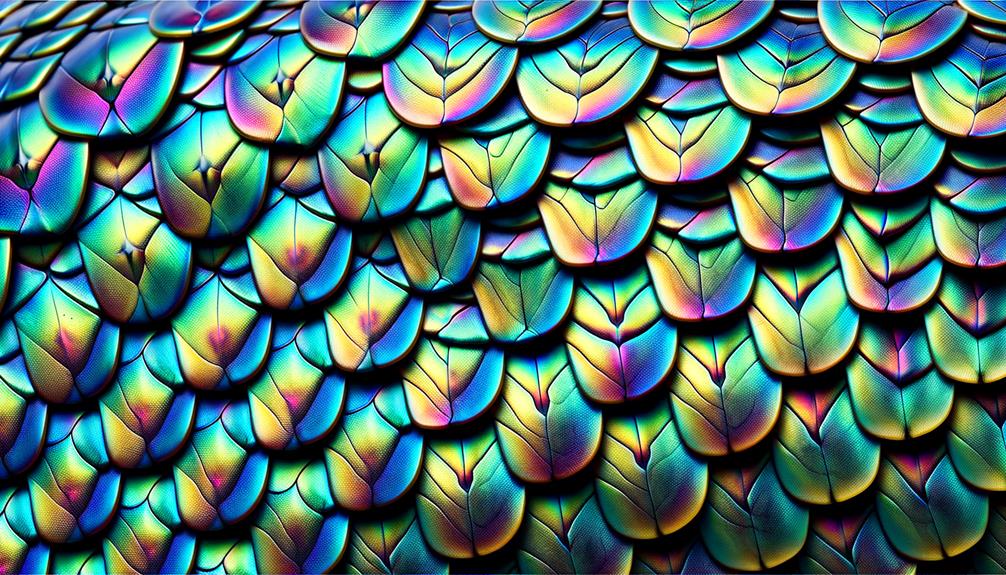I've always been fascinated by reptiles' remarkable ability to regenerate. Lizards, for instance, can regrow their tails using stem cells. This process involves the formation of a blastema and key signaling pathways like Wnt/β-catenin. Crocodiles take it a step further, regenerating spinal cord tissue, which has significant implications for medical breakthroughs. Researchers like Dr. Thomas Lozito are studying these mechanisms to develop human applications, such as treating osteoarthritis and spinal injuries. Geckos, with their exceptional regenerative abilities, may hold the key to new treatments for cartilage and nerve regeneration.
Key Takeaways
Lizards, snakes, and crocodiles have remarkable regenerative abilities, including the power to regrow tails and repair spinal cords.
Geckos can regrow their tails almost perfectly, offering valuable insights for potential medical applications in humans.
The formation of a blastema and Wnt/β-catenin signaling play critical roles in the regrowth of reptilian limbs.
Crocodiles and alligators can regenerate severed spinal cord tissue, which is helping researchers develop new ways to repair nerve damage.
By studying reptilian regeneration, scientists hope to find new treatments for osteoarthritis and spinal cord injuries in humans.
Regenerative Abilities of Reptiles
When exploring the regenerative abilities of reptiles, it's remarkable to see how creatures like lizards, snakes, and crocodiles can regrow tails, fangs, and even entire limbs with remarkable precision. Lizards, for instance, can regenerate their tails, a process that fascinates researchers in stem cell biology. The tail regeneration in lizards involves stem cells that multiply and transform into various tissues, including cartilage, without forming bone, offering a model for potential breakthroughs in regenerative medicine.
Researchers Dr. Thomas Lozito and Dr. Rocky Tuan at the Keck School of Medicine have made significant contributions to studying these processes. Their work examines how stem cells and specific signaling pathways facilitate wound healing and tissue regrowth. By understanding these mechanisms, we can potentially apply this knowledge to human applications, such as treating osteoarthritis and spinal cord injuries.
Geckos, known for their exceptional tissue repair capabilities, offer further insight into regenerative biology. Unlike humans, whose wound healing often results in scar tissue, reptiles can achieve near-perfect regeneration. This extraordinary ability highlights the untapped potential within regenerative medicine, urging us to explore and harness these biological capabilities for human health advancements.
Mechanisms Behind Limb Regrowth

Understanding how reptiles achieve remarkable regenerative feats requires examining the intricate mechanisms behind limb regrowth. For instance, when a lizard loses its tail, it can regenerate the missing structure through a fascinating biological process. This process involves forming a blastema, a mass of proliferating cells that serves as the blueprint for the new limb.
The blastema is primarily composed of progenitor cells, similar to stem cells, which differentiate into the various tissues needed – muscle, skin, and cartilage – to recreate the limb. Signaling pathways, such as the Wnt/β-catenin pathway, play a central role in guiding these cells, ensuring they form a well-organized, functional limb.
Interestingly, the immune system also plays a crucial role. Specific immune cells, such as septoclasts, help inhibit fibrosis and scarring. This anti-scarring action is critical for allowing the regenerative process to proceed smoothly. Unlike typical wound healing in humans, which often results in scar tissue, lizards avoid this pitfall.
Insights from lizard limb regeneration offer promising applications in human biology and surgery. For example, inducing cartilage regeneration by transplanting specific cell types could provide new treatments for conditions like osteoarthritis. The study of these regenerative mechanisms is not only fascinating but also holds significant potential for medical science.
Spinal Cord Repair in Reptiles

Spinal Cord Repair in Reptiles
Few natural phenomena are as astonishing as the ability of certain reptiles to regenerate their spinal cords, restoring both motor function and sensation after severe injury. Crocodiles and alligators, for instance, exhibit this remarkable capability, regrowing severed spinal cord tissue and re-establishing neural connections. This feat of healing has captured the attention of researchers in medicine and orthopaedic surgery.
Dr. Wesely Lozito, at the University of Southern California's Keck School of Medicine, studies these reptiles to uncover the molecular mechanisms behind their regenerative prowess. Supported by the National Institutes of Health, his team has identified key signaling pathways and cell types involved in this process. These components are often absent or impaired in mammals, offering a fascinating glimpse into evolutionary biology.
To understand the depth of this research, consider the following:
- Cell Biology and Regenerative Medicine: Dr. Lozito's team is working to identify the specific cells that facilitate spinal cord regeneration in reptiles.
- Tails as a Model: Reptilian tails are being used as a model system to study nerve regeneration mechanisms. This approach helps researchers better understand how reptiles can regrow their spinal cords.
- Comparative Analysis: By comparing spinal cord regeneration in reptiles versus mammals, researchers hope to identify potential therapeutic targets that could lead to new treatments for human spinal cord injuries.
Medical Applications for Humans

Harnessing the regenerative abilities of reptiles could transform medical treatments for humans, offering new hope for conditions like osteoarthritis and spinal cord injuries. Imagine using a lizard's capacity for cartilage regeneration to treat millions suffering from osteoarthritis. Researchers are now focusing on applying this ability to orthopedic surgery, specifically targeting cartilage repair. By understanding how lizards regenerate cartilage that doesn't turn into bone, we could make significant strides in regenerative medicine.
One promising approach involves implanting lizard immune cells called septoclasts into the limbs of mammals. These cells have shown remarkable potential in inducing cartilage growth, indicating a new frontier for tissue engineering. This method also provides a glimpse into how we might repair spinal cord injuries, restoring lost functions and giving people affected a new lease on life.
Advancements in stem cell research are key to these breakthroughs. By mimicking reptilian regenerative abilities, we can develop personalized treatment approaches tailored to individual patients' needs. This could fundamentally change how we address severe injuries and chronic conditions, freeing individuals from the constraints of their ailments. By learning from our reptilian counterparts, we're on the cusp of a medical breakthrough that promises unprecedented healing potential.
Future of Regenerative Medicine

<|start_header_id|>
Frequently Asked Questions
What Reptile Has the Best Regeneration?
When it comes to regeneration, salamanders, specifically axolotls, stand out. These remarkable creatures can regrow complex limbs and tails that are almost identical to the originals. Their ability to regenerate body parts surpasses that of other reptiles.
What Reptiles Can Regenerate Limbs?
Imagine losing a limb and growing it back. Some reptiles have this incredible ability. Crocodiles can regenerate damaged limbs, while certain lizards, like the crested gecko, can regrow their tails. This remarkable ability showcases nature's regenerative power.
Is Regeneration Possible in Humans?
Regeneration in humans is still a developing field, but researchers are making progress. By studying how lizards regrow their body parts, we hope to unlock the secrets of cartilage repair and potentially regrow human limbs and organs in the future.
What Animal Can Regenerate Its Spine?
I've always been amazed by axolotls' incredible ability to regrow their spinal cords, restoring full motor function. Other animals, like lizards, geckos, and crocodilians, can also regenerate parts of their spines, but none come close to the axolotl's remarkable healing powers.



